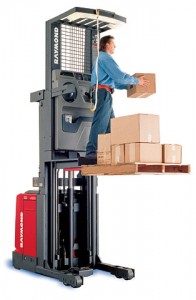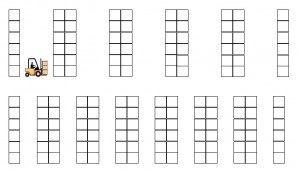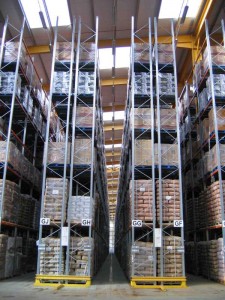One method of maximizing floor space in a warehouse is to use Very Narrow Aisle Racking (VNA). Very narrow aisle racking refers more to the layout of the racks, rather than the racks themselves.
How Very Narrow Aisle Racks Maximize Floor Space
The aisles in a standard warehouse layout are wide enough for a forklift to turn 90 degrees, take a pallet from the rack and turn again to continue down the aisle. Depending on the size of froklift used, or whether you are using a reach truck instead of a forklift, the aisles must be at least 10’ wide and are usually closer to 14” feet.
With very narrow aisle racking, the aisle are only wide enough for a forklift or reach ruck to move in one direction. They cannot turn! The aisles width can be as narrow as the forklift is wide. By reducing aisle width, more floor space is available for racks. Consider the following sketch.
The top diagram shows a standard pallet rack configuration with an aisle width of 12 ft. All racks are accessible. In the lower diagram, the racks are laid out in a VNA configuration. There is an increase of 40% more racks stored with VNA racks compared to standard pallet racks, simply because the aisles are smaller.
So what’s the catch?
How are you going to get your pallets if you can’t turn the forklift to face them?!
You need specialized equipment to work with VNA racks. Forklifts and reach trucks that load and unload pallets from the side are critical to any warehouse or distribution centre using VNA racks. These specialized forklifts don’t have to turn to reach the pallets on each rack. They are driven straight to the rack where your pallet is stored, the forks extend from the side to pick up the pallet, and the forklift continues to drive straight. Some forklifts articulate, so the load can be picked from the side, then turned to face forward. This enables the forklift to pick from both sides of the aisle.
In addition to specialized forklifts, the VNA racks themselves may have extra features added. If you want to drive a forklift at any significant speed through a VNA aisle, you will need a guidance system, to prevent the forklift from hitting the sides. Mechanical rails and rollers or inductive guidance systems are added to the racks to prevent the forklifts from hitting the racks. Even with these guidance systems, it’s unlikely that a VNA forklift will travel as fast as a standard counter balanced forklift.
The additional storage benefits of VNA racks are clear, but if they are so great why doesn’t every warehouse use them?
Things to Remember When Considering VNA Racks
1. Cost of specialty equipment.
Just the forklift can cost three to five times as much as a standard forklift. Since VNA forklifts are not as straightforward to operate, they are designed with additional features to be as safe as possible. With the addition of a guidance system on the racks, the upfront costs can be significant.
2. Training and licensing of personnel
VNA forklifts are not as simple to drive around as a regular forklift. They may require special licenses depending on what state or country you live in. Since they are not as common as counter balance forklifts, there are less people qualified to operate them. It may be hard to find a trained driver, unless you want to invest in the training yourself.
3. VNA forklifts cannot load trucks.
Since VNA forklifts load from the side, they cannot load and unload trailers from regular loading docks. Additional counterbalance forklifts will be required to service the loading and shipping areas. Different forklift types add complexity and extra handling.
4. Safety.
An ideal aisle in a very narrow aisle warehouse is only marginally wider than the width of the forklift. This means that forklifts will be traveling at high speeds, only a few inches from the racking. This requires extra skill on the driver’s part, even if guidance rails have been put in place. Very narrow aisle racking is inherently more complicated and there is added risk involved with having everything so close together.
Very Narrow Aisle Racks with Order Selectors.

Many distribution centres use very narrow aisle racking with order selector forklifts. In these distribution centres only one or two of each part number is required for each order. The forklift has no reason to bring down an entire pallet of material to select one part. Rather than bring the pallet down, the forklift brings the operator up to the pallet.
Order selector trucks have a platform that the operator uses to move up and down. The operator needs to wear a safety harness while the platform is raised. Using an order picker forklift with narrow aisle racking is becoming standard practice for distribution centres with millions of SKU numbers.
Return to main Warehouse Racks page.

